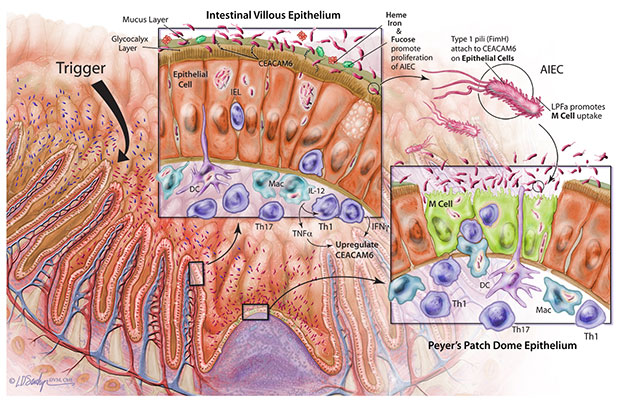
Medical illustration in the veterinary specialty combines advanced education in science and art. For insights into this line of work, AVMA News interviewed four experts about this unique profession, the challenges these professionals face, and how they’ve developed their careers. This is the third article in our three-part series.
Connecting the art and science behind veterinary illustrations
One of Dr. Diogo Guerra’s main goals as a medical illustrator is to increase the quantity and quality of visual education materials for veterinarians.
“Ultimately, I’m not trying to create beautiful images per se but to design educational materials that work and effectively communicate information,” said the veterinarian and freelance veterinary medical illustrator. “Communication is a fundamental part of every health care professional’s job, regardless of whether they work in research or at a veterinary hospital.”
Similarly, Dr. Lauren D. Sawchyn, another veterinarian turned medical illustrator, explained there is a huge need for veterinary illustration, but there is a lack of awareness of the expertise available and of funding for illustration.

“I would love to see a future where every vet publication has high-quality images and every veterinary school and business … has a department of medical illustration and animation with certified illustrators, along with medical photographers, designers, and art directors,” Dr. Sawchyn said. “The value that these teams bring to those institutions is immeasurable.”
Another challenge in veterinary illustration is finding clients that understand the value of the work. Hours of research and effort go into each piece, not to mention illustrators’ training and overhead expenses.
“I am pleased that clients admire our work, but I was discouraged to find that many buyers of illustration shop for the lowest price and the quickest turnaround instead of the highest quality,” Dr. Sawchyn said.
Medical illustration is created and then licensed for a specific purpose, time frame, and use. However, the internet can mislead clients into thinking this content is usually available to use for free.
“Artists are frequently the victims of copyright infringement, their work changed and used without permission or compensation and signatures stripped from images,” Dr. Sawchyn said. “For many of us, our livelihood depends on our copyright.”
Collaboration is key
Veterinary illustration is valuable for client education, publications, teaching, presentations, and many other uses. Artists work collaboratively in all areas, whether illustrating textbooks for cell biology, making prosthetics, or directing art for pharmaceutical companies.
At the University of Tennessee, Deborah Haines praised the great faculty members she’s worked with who understand her skill set. She stressed that as a medical illustrator, collaboration is key.

This is true in Dr. Guerra’s freelance work as well. “I honestly feel my work is a true partnership with my clients,” Dr. Guerra said. “I collaborate with researchers and clinicians–from veterinary to human medicine, microbiology and pharmaceutical sciences.”
“All illustration clients have a story to tell and a problem to solve,” Dr. Sawchyn said. “Science is a language, and medical illustrators translate this language to broad audiences using a visual language.”
Careers in veterinary illustration
Some veterinary illustrators work in medical schools or veterinary schools. Others work for textbook publishers or make medical illustrations for legal cases. Freelance work is a popular choice for illustrators. According to the Association of Medical Illustrators, approximately one-third of medical illustrators are self-employed.
“There are several ways of becoming a medical illustrator, and each pathway is unique and valid,” Dr. Guerra said. “I have started in the medical side of things and, through courses and practice, found my way into the field.”
Dr. Guerra emphasized that people should build a solid scientific foundation and an excellent understanding of visual communication, art-related legal matters, and good business practices.
“What I feel is key for a successful career in medical art is to find a niche that you like, that needs illustrations, and where your background can be a competitive advantage,” Dr. Guerra said.
Dr. Sawchyn’s background included intensive training in animal anatomy and medicine in addition to the human anatomy training she had, and that background prepared her to work in the niche market of veterinary illustration.
“I understood my veterinarian clients, and I made great connections in the veterinary field,” Dr. Sawchyn said. “My medical illustration mentor and professor, Bill Andrews, always would say, ‘Plan the work, and work the plan.’ I think this goes for anything you do.”
Medical illustrators are always learning, and Haines laughed thinking of her less-refined illustrations from when she first started working. “As media changes, you can’t rest on your laurels,” Haines said. “Hopefully you build on what you learned from the previous project.”
Haines explained that her favorite project is “always the next project. It stretches you, and you learn new concepts and help someone else along the way to learn.”
A version of this article appears in the February 2023 print issue of JAVMA.